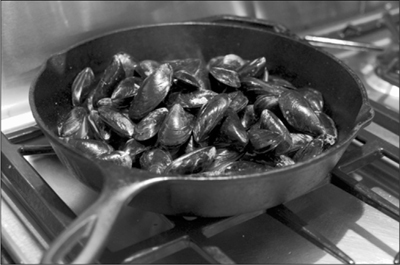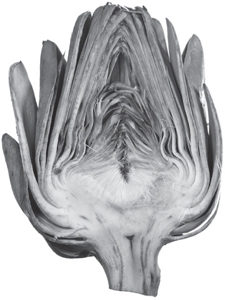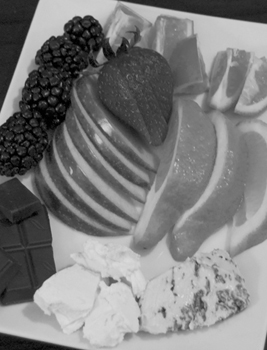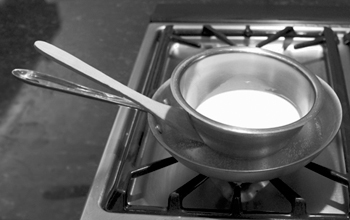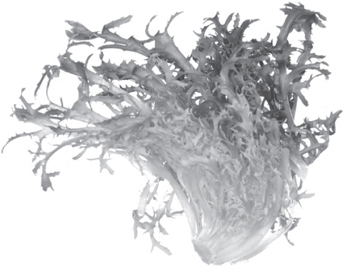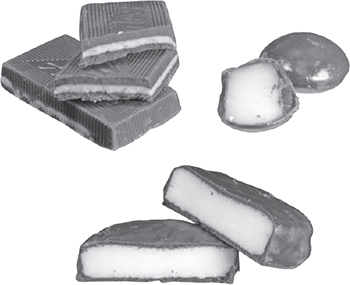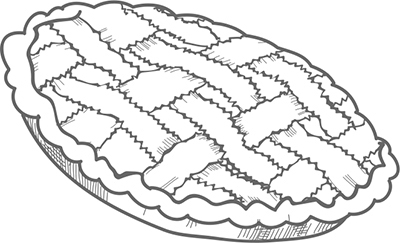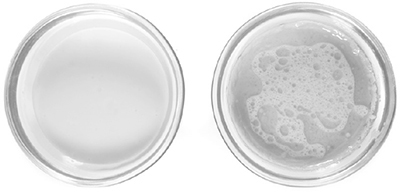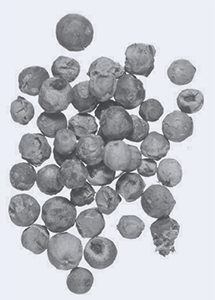2
Taste, Smell, and Flavor
Recipes
Roasted Poblano and Cheddar Cheese Stuffed Pork Chops
Pan-Seared Mussels with Butter and Shallots
Frisée Salad with Poached Eggs and Lardons
Summer Watermelon and Feta Cheese Salad
Béchamel Sauce, a.k.a. White Sauce
Espagnole Sauce, a.k.a. Brown Sauce
Fresh Basil, Tomato, and Mozzarella Salad
Fennel, Portobello Mushroom, and Parmesan Salad
Interviews
Linda Bartoshuk on Taste and Pleasure
Brian Wansink on Expectations, Flavor, and Eating
Lydia Walshin on Unfamiliar Ingredients
YOU OPEN YOUR FRIDGE AND SEE PICKLES, STRAWBERRIES, AND TORTILLAS. What do you do? You might answer: create a pickle/strawberry burrito. Or if you’re less adventurous, you might say: order pizza. But somewhere between making a gross-sounding burrito and ordering takeout is another option: figuring out the answer to one of life’s deeper questions: how do I know what goes together?
The answer is, as with so many things, “It depends.” It depends on your past experiences and what you’ve learned to like. It depends on your cravings as you stand there in front of the fridge pondering pickles, strawberries, and how your life has reached the point where your fridge holds only three ingredients. And it depends on how the ingredients will taste together based on how your tongue and nose sense the tastes and smells of the foods you’re eating.
The best inspiration for blissful deliciousness is to pick good culinary inputs: ingredients that carry good flavor, generate pleasing aromas, and make your mouth water. True, you also need good technique once the ingredients land in the frying pan, but no cook can save truly bad ingredients. By understanding how flavor is created and detected, you’ll be better able to answer that deeper question of culinary combinations and inspiration.

Taste + Smell = Flavor
Experienced cooks can imagine the flavor a combination of ingredients will have without picking up a fork. For them, predicting what combinations will work well comes from remembering what worked in the past and noticing patterns in recipes. But what is flavor? And how can you learn to better predict what will work well together?
Flavor is based on the combination of taste, the gustatory sensations from your tongue, and smell, the sense of olfaction from olfactory receptors in your nose. Our brains also factor in a little bit of other data picked up by our mouths, such as texture and oral irritation from chemicals (think hot peppers or peppermint). There are also some minor nuances (some would say nuisances) from cues like color that can sway what we think we’re tasting, but those aspects aren’t as much about flavor as they are perception.
All of the senses that create the sensation of flavor are based on chemistry. Your tongue detects compounds that trigger sensory cells in a taste bud, usually with the aid of saliva. Your nose detects volatile compounds—chemicals that easily evaporate from their source—as they’re carried by air passing through the nasal cavity. The next time you chomp down on a strawberry, keep in mind that the flavor you sense is based on some of the strawberry’s compounds triggering taste receptors in your taste buds and other compounds evaporating and triggering olfactory neurons in your nose.
Our brains trick us into thinking that the sensation of flavor is a single input, but in reality our “sense of taste” is created by our brains. We usually use the word “taste” when we mean flavor, but from a technical perspective, a good strawberry only tastes sweet. That taste combines with a fruity, complex smell to create the flavor of a strawberry. For us to drill down into the science of taste and smell, it’s an important clarification: taste is what your tongue does, smell is what your nose does, and flavor is the combined sensation your brain creates from fusing the signals from multiple senses. We’ll spend the rest of this chapter diving into the specifics of taste, smell, and flavor, but a few key guidelines for creating amazing meals are worth pointing out here:
• Start with good ingredients. No amount of culinary wizardry can create all of the taste and smell molecules missing in low-quality ingredients.
• Use proper technique. Your tongue and nose can’t detect compounds that are bound up inside food. Slicing through produce, combining ingredients, and heating foods free compounds such that you can detect them and also transform them into other compounds, changing what’s available for you to sense.
• Season with all the taste modifiers, not just salt. Adding ingredients like salt, sugar, and lemon juice changes the detection thresholds of volatile compounds and alters unpleasant compounds. Adding a pinch of salt can “add” flavors by lowering the threshold necessary for you to detect them while also masking bitter flavors; adding lemon juice can neutralize off-smelling amino compounds.
Taste, the Gustatory Sense
Our sense of taste is an amazing accomplishment of biology and evolution, and for good reason: it steers us toward nutritious, energy-rich foods (sweet, savory) and biologically necessary building blocks (salty), and away from potentially harmful foods (sour, bitter).
The four foundational tastes of Western cuisine—salty, sweet, sour, and bitter—were first described 2,400 years ago by the Greek philosopher Leucippus (or more likely one of his grad students, Democritus). The ancient Chinese included a fifth taste, pungency/hot, and indeed spicy foods as well as cooling ingredients are detected in gustation. Another taste, savory, was described and popularized about a hundred years ago by a Japanese researcher, who identified a “meaty” taste triggered by amino acids, which he named umami. More recent research hints at additional taste receptors for rancid fatty acids (“oleogustus”), some metals, calcium, and possibly even water, although these are unlikely to ever be considered tastes in a culinary sense.
The receptors for sweet, bitter, and umami compounds are known to also exist elsewhere in the human body. Sweet receptors in the gut, for example, respond to sugar and send positive signals to the brain; there’s a reason eating and swallowing good food is so satisfying! Other animals take this further and rely on receptors for tasting located in other parts of their bodies. Fish taste using their lips; flies can taste what they walk on through their feet.
By itself, taste is the lesser part of flavor, accounting for somewhere around 20% of the sensation of flavor, with the other 80% or so coming from smell. As the more primitive part, though, taste is easier to understand, so we’ll start with it. The human tongue contains a few thousand taste buds, each of which is a group of 50 to 100 receptor cells. (The little dots you see on your tongue contain some of the taste buds, but taste buds exist elsewhere, too—even on the palate, the roof of the mouth.) Each of these cells can interact with various types of chemicals, which are carried to them by our saliva as we chew food. It’s these receptor cells that originate the signals for various tastes. Once activated, the receptor cells transmit the signals to our brains, which assemble all the signals into a relative strength for the taste.
The magic of taste starts with receptor cells. The standard metaphor for how they work is that of a lock and key. Tastants—chemical compounds that trigger a taste, such as sucrose in table sugar or sodium in table salt—act as keys, fitting into “locks” on our receptor cells. Different families of compounds fit into different locks, so a particular taste perception can be thought of as a single key matching a single lock. When you taste sugar, your brain registers “sweet” based on which taste receptor cells sugar can bind to and the subsequent neurological pathways between those cells and your brain.
Each sense of taste comes from a different type of taste receptor cell, but multiple receptors can lead to the same taste sensation. It’s estimated that there are around 40 different types of receptors on the tongue, with multiple ones for the same taste. Salt, at least in mice, is detected by two different receptors, one for low concentrations of sodium and a second that activates with higher concentrations. Sweet tastes can also be triggered by two different receptors, called T1R2 and T1R3. Differences in compounds will also determine how quickly they fit into the “lock” of the receptor and how long they activate it, leading to different timing sensations between tastants. This lock-and-key metaphor isn’t perfect, though—the strength of one taste sensation can be moderated when another one is detected.
How strongly we register a taste is based on how much of a compound is present in a food we’re eating and how sensitive we are to it. Just as our other senses have thresholds for sensing (e.g., few of us can hear anything at 2 dB, while almost all of us can hear something louder than 15 dB), taste and smell have minimum absolute thresholds. Take a look at this chart showing reported values for sensitivity thresholds of common taste reference compounds, expressed in parts per million (i.e., for us to taste these compounds, they have to be present at or above these concentrations, called suprathreshold; take these numbers with a grain of salt, though, as they’ll change based on many factors).
Sweet |
Sucrose |
5,000 ppm |
Salty |
Sodium chloride |
2,000 ppm |
Savory |
Glutamate |
200 ppm |
Sour |
Citric acid |
40 ppm |
Bitter |
Quinine |
2 ppm |
Hot |
Capsaicin |
0.3 ppm |
Our sensitivity to different common compounds reveals a lot about their importance. A quick glance shows that we’re much more sensitive to sour, bitter, and irritating compounds. These generally denote unsafe food, like spoiled foods that have turned sour, or poisonous items, which generally register as sour or bitter. Evolutionarily speaking, this is no surprise; any organism that avoids chowing down on something dangerous has a better chance of passing along its genes!
You’ll notice capsaicin in the list. Capsaicin is the compound that makes hot peppers hot, and it’s an example of chemesthesis—the sensation of chemicals. Our taste buds, like much of our skin, can detect irritation brought on by chemicals such as ethyl alcohol and capsaicin. Other chemicals, like menthol, activate cooling sensations. These types of compounds tickle other aspects of our taste buds and influence flavor, and are why it’s incorrect to think of the tongue as only sensing four or five tastes. Different cultures place different emphasis on these sensations in their culinary traditions—many Indian dishes and southeast Asian cuisines put an emphasis on pungent, hot tastes, while the Japanese base much of their cuisine around savory/umami tastes.
Regardless of which types of cuisine you enjoy, the approach to cooking them is the same: try to balance the various tastes to a level that’s desirable (e.g., not too salty, not too sweet). There are a number of practical challenges in creating balanced tastes, and understanding them can elevate your cooking game significantly. How you prefer tastes to be balanced depends in large part on how your brain is wired and trained to respond to basic tastes. Here are a number of different aspects of taste to be aware of when cooking, both for yourself and for others.
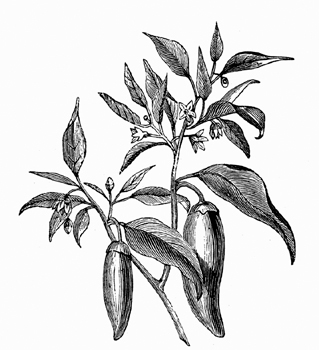
Remember to season! Knowing all the science of taste won’t make a dish taste any better if you don’t pay attention to your senses. Learn to really taste things. See if you can notice changes in tastes and smells as food finishes cooking, and take time to taste a dish and ask yourself what would make it better. Adjusting the seasonings at the end may seem obvious, but it’s a common step people forget. A pinch of salt or squirt of lemon juice can do wonders to balance tastes.
Your cultural upbringing will affect where you find balance in tastes. What one culture finds ideally balanced won’t necessarily be the same for another culture. Americans generally prefer foods to taste sweeter than Europeans. Savory is a key taste in Japanese cuisine but has historically been given less formal consideration in the European tradition (although this is starting to change). Flavor preferences begin to develop before birth—mothers eating foods like garlic during pregnancy will impact the child’s food preferences, and fetal facial reactions can be seen in the third trimester in response to pleasurable and adverse-tasting foods. This is all to say that, when cooking for others, what you find just right might be different than someone else’s idea of perfection, no matter if it’s one shared meal or a lifetime of shared meals with a partner.
What you just ate can influence what you taste next. When you’re serving different dishes, the tastes from one dish can linger and impact the experience of others—an effect called taste adaptation. Most of our senses adapt to a signal after a while, so that we’re able to pick up on other changes. A sweetened yogurt, for example, will become less sweet as you continue eating it, and that adaptation can carry over to the next thing you taste. The next time you brush your teeth, try sipping some orange juice afterward and notice how much more bitter it is. (Sodium lauryl sulfate in toothpaste sticks around for a little while, knocking out your ability to sense sweet.) Carbonated beverages like effervescent mineral water are traditional palate cleansers, although studies suggest crackers are more effective. That bread basket on the table isn’t just about filling you up: eating bread also clears out tastes when you’re switching between foods!
Taste adaptation occurs when your perception of taste is altered by prior sensations, sort of like a visual afterimage, while taste perversion happens when a compound changes how your sense of taste registers things. See page 71 for more on taste perversion.
Environmental factors affect how you taste things. Drier conditions change the amount of saliva in the mouth, resulting in a decrease of taste sensitivity. Airline food suffers for this reason; salty tomato juice and pretzels are commonly served at altitude, as they have strong tastes. Our sense of taste changes with the weather!
Temperature also impacts taste sensation: foods served warmer (by some accounts, above 86°F / 30°C) will be detected as stronger by the taste buds than colder dishes, due to the heat sensitivity of some of the taste receptor cells. There’s a fun quirk of biology here: foods served below body temperature don’t register as warm, so a dish served slightly below body temperature won’t seem warm but will still convey stronger tastes. Colder foods, on the other hand, result in tastes with lower perceived strength, especially for sugars. There’s a reason why warm soda is gross: it tastes sweeter (cloyingly so) than when it’s cold. When you’re in the kitchen, keep the impact of temperature on your sense of taste in mind when making dishes that will be served cold. You’ll find the frozen versions of things like ice cream and sorbet to be weaker-tasting and -smelling than their warmer, liquid versions, so adjust the mixtures accordingly.
Genetic differences can change how you taste things. What you and I taste isn’t necessarily the same. The most researched area of genetic taste differences uses the bitter-tasting compounds propylthiouracil (PROP) and phenylthiocarbamide (PTC) for understanding how we interact with foods. Some of us can’t taste these compounds—myself included—while others taste them as bitter. It’s not a binary “can or can’t” taste but appears to be correlated with two genes, along with a few other genetic aspects. Based on one’s genetic makeup, the bitter sensation can be unbearably revolting. I had one friend almost reflexively punch me upon tasting a PTC test paper—clearly an extraordinary taster. (See page 82 to learn how to test taste differences; for an interview with Linda Bartoshuk, who has extensively researched this area, see page 86.)
Being able to taste PROP or PTC isn’t necessarily good or bad; it’s just different. Those who taste them will experience some foods—especially dark-green leafy vegetables such as kale, cabbage, broccoli, and Brussels sprouts—as more bitter because of phenylthiourea-like compounds that their tongues can sense. PROP/PTC tasters generally also have a higher number of taste buds on their tongues, resulting in a larger number of cells that can experience oral irritation. This quirk causes them to taste astringent, acidic, and spicy foods as stronger as well. Caffeine tastes more bitter to PROP/PTC tasters, which explains why researchers find these tasters are more likely to add milk or sugar to coffee and tea, which cancels out some of the bitterness.
As you can see, a small difference in the ability to taste one family of bitter compounds can cascade through a bunch of other tastes, changing the balance of tastes that someone may want. There’s some evidence for genetic differences in the ability to taste savory compounds like glutamate; who knows what other differences exist.
Physiological issues can also impact taste capabilities—notably, age, stress, and disease. As we age, our taste preferences shift. A kid’s sweet tooth comes from a biological drive for high-calorie foods; older seniors also have shifts in smell capabilities and become less sensitive to salt and some mildly bitter tastes. (It appears that tastants like sodium and sucrose have slight odors associated with them, so there’s some impact on taste thresholds from decreased smell.) For the elderly, loss of taste sensations can be a real issue—it’s hard to eat bland food. Stress also impacts taste by leading to an increase in the hormone cortisol, which, among other things, dampens the stimuli strength of taste buds. And finally, there are a broad range of diseases that can affect our sense of taste, most of which are rarely diagnosed in the nonelderly population (how would you know you have specific aguesia—taste blindness—when you can’t tell what somebody else experiences?). While understanding the physiological issues won’t change what someone tastes, it can explain the behavior you see in the way people around you eat.
From this short list of the ways that taste is impacted, you can see that taste is not as simple as the four basic sensations of salty, sweet, sour, and bitter described by the ancient Greeks. We’ll examine the various aspects of taste, along with recipes and experiments, over the first part of this chapter.
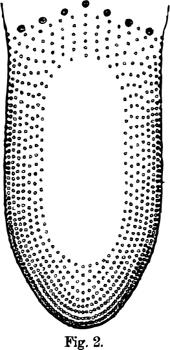
The erroneous idea that primary tastes come from different parts of the tongue started with a mistranslated paper. All regions of the top surface of the human tongue can detect primary tastes. There are small differences in sensitivity per region, which is why different parts of the tongue sense different tastes more acutely. The back of the tongue is more sensitive to bitter than the front, while the front is more sensitive to sweet than the back, so a weakly bittersweet liquid will seemingly change taste on different parts of the tongue.
Salty
We taste foods as salty through a relatively simple biological mechanism: sodium ions from salt activate salty-taste-specific receptors by way of ion channels—essentially a gated passageway into a cell—which then complete an electrical circuit that sends the brain the message “salty!”
Of all the primary taste sensations, our mechanism for sensing salty tastes is unique in its detection of a specific compound, sodium. Almost nothing else triggers the taste of saltiness; ion channels are very selective about what they bind with. Sodium is a biological necessity regulated by the kidneys and used to control blood pressure, enable cellular communication, balance water levels, and manage a whole lot of other things. Our lives depend on us eating enough of it. Given its biological importance, our ability to specifically taste salt and crave it makes sense. As with sweetness, our cravings for salty tastes are related to what our bodies need at any given moment.
Iodized salt has the element iodine added as a nutritional fortification against diseases like goiter, which is why it’s no longer an issue in countries like the United States. Controlled experiments show no taste difference between iodized and noniodized salt when used in foods at normal concentrations.
The word salty describes the taste, while salt defines a chemical compound. Table salt refers to sodium chloride specifically; and unless you’re talking chemistry, this is the type of salt meant when the word salt is used. From a chemistry perspective, there are other types of salts besides sodium chloride. One salt, potassium chloride, does taste salty but also has a bitter taste. If you look at the ingredient labels for salt substitutes, you’ll see other compounds added to moderate that bitterness. Other salts you might know of, such as Epsom salt (magnesium sulfate), also taste bitter. Salts that contain lithium instead of sodium taste salty because lithium ions (Li+) can permeate the salty taste cells’ ion channels. I feel sorry for the chemist who discovered this, though—lithium is toxic in large doses! (For culinary uses of these other types of salts, see page 382.) In almost all cases, salty tastes are brought about by sodium ions from table salt, so you can assume if you’re tasting salt, it’s because of sodium chloride.
It’s the sodium ion (Na+) in sodium chloride that tastes salty; the chloride ion (Cl–) merely stabilizes the sodium in solid form. For the taste of salty to register, the sodium ion has to complete the ion channel’s circuit. This is a subtle but important point for eaters needing to regulate their salt intake: how salty a food tastes cannot be used to detect how much salt is present! Sodium ions, being extremely small, easily permeate into the foods they’re cooked with, and once constrained, won’t come into contact with the salty taste receptors. A large amount of salt added early on in the cooking process can be absorbed into a food’s interior, meaning you won’t taste it but you will still digest it, leading to an increased sodium intake. Be aware of this if you’re cooking for people on low-sodium diets!
Very, very weak solutions of salt will taste sweet! Sodium ions appear to activate the sweet receptor, but the exact mechanism isn’t yet known.
Adding salt can change the way other tastes register and alter the way we sense smells. Taste receptors aren’t perfect, one-to-one detectors for the various compounds. Salty and sour tastes can mask each other because sodium can slightly interfere with our sour taste receptors. Adding a pinch of salt to baked goods doesn’t necessarily make the food taste salty, but it will reduce sourness, which in turn increases the perception of sweetness! The addition of a small quantity of salt (not too much!) enhances other foods, bringing a “fullness” to foods that might otherwise have what is described as a “flat” taste. This is why so many sweet dishes—cookies, chocolate cake, even hot chocolate—call for a pinch of salt. How much salt is in a pinch? Enough that it amps up the food’s flavor, but not so much that it becomes a distinct flavor in itself.
DIY Sea Salt
Making your own salt is easy—if you live near the sea and don’t mind slopping some buckets of water home. Fill a few 2-quart (2-liter) containers with pleasant-smelling seawater and return home. Pour the water into a large pan, straining it through a clean cloth or coffee filter to remove any sand and particulates. Boil the water down to about a fifth or sixth of its original volume, pour it into a shallow glass pan, and allow it to dry as it evaporates over a day or two. Expect to get about ¼ cup (65g) salt per 2-quart container.
Making salt via evaporation removes the water instead of extracting the salt. This means anything else in the water, from subtle flavorings and trace minerals (good) to toxic mercury (bad), will be present in the salt. Using it once isn’t an issue, but I’d avoid a life-long habit of using DIY sea salt.
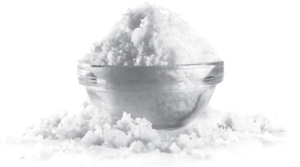
In larger quantities, salt acts as an ingredient as much as a taste enhancer. Mussels liberally seasoned with salt, bagels topped with coarse salt, salty lassi (an Indian yogurt drink), and even chocolate ice cream or brownies sprinkled with sea salt all taste inherently different without the salt. When using salt as a topping, use a coarse, flaky variety (look for sea salt), not rock/kosher salt or table salt—you’ll need less salt for the same salty sensation this way.
Tips |
• Avoid “hidden salt” by using only the amount needed in the early stages of cooking to trigger chemical and physical changes, and then adjust salt levels for taste at the very end of cooking. • A pinch of salt isn’t an exact measurement. Traditionally, it’s the amount of salt you can pinch between your thumb and index finger, but if you need to start somewhere, try using ¼ teaspoon (~1g). • Because of genetic differences in the way people taste some bitter compounds, different eaters will desire different amounts of salt to mask bitterness in foods like broccoli, Brussels sprouts, and kale. Leave a salt shaker on the table to allow eaters to balance tastes! • The amount of salt you prefer is in part based on your last few months of eating patterns—your body will learn to prefer less or more salt over time. |
To make something taste saltier |
• Add salt (duh) or add savory-based ingredients (increasing the savory/umami sensation amplifies salt perception; for savory ingredient suggestions, see page 63). |
If a dish is too salty |
• If it’s only slightly oversalted, increase the sweetness or sourness to mask. • Dilute the salt by adding more ingredients to the dish. (The old trick of adding a potato to oversalted soup does little to decrease the sensation of saltiness but does dilute the concentration of salt.) |
Sweet
As with salt, we’re hardwired to like sweet foods. Sweet tastes signal quickly digestible calories and thus fast energy, which would have been more important in the days when picking up the groceries also involved picking up a spear. Just as the taste of saltiness tempts us to eat biologically necessary salt, the taste of sweetness entices us to eat life-sustaining, energy-rich foods. Our desire for sweetness changes over our lifespan, decreasing as we mature. A child’s preference for sweet things is biologically related to the physical process of bone growth. (Quick, kids, run and tell your parents that your sweet tooth is because of biology!)
Cats can’t taste sugar! Different animals have evolved to have different taste receptors based on their diets. Most pure carnivores—cats included—don’t ingest carbs as part of their natural diets and appear to have no sweet detectors.
The taste cell receptors that trigger “sweet” messages are more complicated than their salty counterparts—not surprising given the difference in complexity between a single sodium ion and the compounds that our bodies can pull apart for energy. For a compound to register as sweet, it has to be able to latch onto two external points on the taste receptor cells that measure sweetness. To do this, the compound has to be shaped such that it can connect to both points and it has to have the right chemical structure to chemically bind at those two points. It’s a remarkably specific “lock” that matches only a few dozen common natural “keys”—almost always various types of sugars.

Compared to sucrose, fructose becomes less sweet as it gets warmer—using it makes sense in cold beverages!
Subtle differences in how well compounds fit into the receptor cell’s “lock” influence how sweet various compounds taste. Common table sugar (sucrose) fits relatively well, while the sugars in milk (lactose) aren’t as adept and thus register as less sweet. The sugar fructose, common in fruits, tastes even sweeter than sucrose at room temperature, but as an excellent example of how complicated chemistry and biology can be, the sweetness of fructose decreases with temperature. The shape of a fructose molecule changes as it heats up, altering its ability to bind to sweet receptors. (For the chemistry geeks: fructose has a few heat-related tautomers—structural variations where a hydrogen atom moves over a spot, swapping the order of adjacent single and double bonds—and the tautomers that occur at warmer temperatures don’t trigger the receptor cells in the same way.)
How we perceive sweetness also depends on how easily a compound binds to the taste receptors and how long it stays bound. Common table sugar, sucrose, makes only a weak connection to the receptor, which is why its onset is slow and it takes us a second or two to register “sweet!” when we taste it. Sucrose has a pleasant lingering taste, even at very high concentrations. On the other hand, fructose binds very quickly to our sweet taste receptors, but also washes away quickly. You’ll find various forms of sweeteners have different taste sensations, ramping up and lingering for different lengths of time. With tasting, it’s not just how strong a sensation is, but how we perceive it over time.
Compounds other than sugar can fit into the sweet receptor’s detector. Lead, in the form of lead acetate, tastes sweet, as the ancient Romans unwittingly discovered. A few proteins, such as monellin, also taste sweet, and can act as sugar substitutes because of how easily they activate our sweet receptors. Sugar substitutes—both those that are synthetically created and those that are selectively extracted from plants—are selected to bind exceedingly well to taste receptors, analogous to examining the lock and designing as perfect a key for it as possible. Stevioside, the family of compounds in the stevia plant responsible for its sweetness, triggers sweetness perception at a dilution 300 to 600 times weaker than we need to detect sucrose; aspartame, a synthetic sweetener, is slightly less potent, noticeable at a concentration 150 to 200 times weaker than sucrose.
The efficacy of sugar substitutes as a weight-control mechanism isn’t as clear-cut as you might think. Recent research is finding that diet sodas lead to more weight gain, although why this is the case is unknown. Possibly our bodies store fat based in part on the sensation of sweetness and not just calories in, or the specific artificial sweeteners may impact our gut bacteria and change how we handle food.
Sugar substitutes can also taste bitter at larger concentrations because of slight similarities between how bitter receptors and sweet receptors work. Some of the bitter receptors accept “twisted,” nonplanar versions of the sugar substitute compounds—a key that fits one lock can potentially fit other locks! This fit issue is one reason why candies that rely on sugar (sucrose) for volume can’t be made with sugar substitutes. Table sugar, as a cooking ingredient, is used for more than its sweet taste: it can bind water, cause and aid in browning reactions, ferment, and crystallize—it’s remarkable how many different roles one simple molecule can fill, so it’s no surprise that more complicated molecules have even more quirks!
The politics of sugar are complicated. Have you ever noticed that nutritional labels on foods in the US give a “percent daily value” for everything except sugar? The World Health Organization says to limit free sugars to 10% of your caloric intake and suggests 5% is ideal.
Tips |
• In a recipe that calls for a specific type of sugar—say, corn syrup—it’s often included for functional reasons, not taste. Corn syrup (100% glucose) inhibits crystal formation, which produces gritty textures, and this is why caramel candies and ice cream bases sometimes call for it. • Modern brown sugar is made from white sugar with molasses added in, at about a 10:1 ratio. If you’re cooking and are out of brown sugar, mix in about 2 tablespoons (30 mL) molasses per cup (200g) of sugar (more for darker brown sugar). • When making sugar syrups for sweetening drinks like iced tea, be mindful of heat. Table sugar in water, when heated and simmered, will break down into fructose and glucose, which taste less sweet. A sugar syrup heated only briefly until the sugar is fully dissolved will taste sweeter than the same syrup heated and simmered. |
To make something sweeter |
• Add sugar, honey, or other sweeteners (see page 63); reduce sour or bitter ingredients. |
If a dish is too sweet |
• Increase sourness (e.g., add lemon juice or vinegar) or spiciness (e.g., add cayenne pepper). • For culinary experimentalists, use a sweetness inhibitor (see page 393). |
Sour
Sour, tart tastes are caused by acidic compounds in foods, and as with sweet and salty tastes, we’re hardwired from birth to react to them. Similar to how we taste salt, the sensation of sourness is detected via ion channels located on sour taste receptors that interact with an acidic compound’s hydrogen ions. Quite literally, your sour taste receptors are primitive chemical acidity detectors. Hydrogen ions trigger sour taste receptors; the more taste buds that are firing, the more sour a food will taste.
Humans are unique in our enjoyment of sour foods. Like bitter tastes, sour tastes are an indicator of potentially dangerous foods; in this case the aversion prevents us from consuming spoiled items. How we came to enjoy sour tastes is a small biological mystery. Somewhere in our past we lost the ability to synthesize vitamin C, likely from regular consumption of fruits high in it; one theory for our learned desire to eat sour foods centers on ensuring that we ingest enough vitamin C to avoid diseases like scurvy.
Regardless of why, we learn to enjoy sour tastes as we mature. Some items—mostly fruits—are naturally sour due to their chemistry. Ascorbic and citric acids in citrus fruits like lemons make them unbearably tart, a reasonable defense against any herbivore that doesn’t know how to cook. Malic acid, common in apples, gives them a delicious tartness. Other foods become sour from spoilage: yogurt, vinegar, fermented pickles, kimchi, and sourdough bread all rely on fermentation, which generates deliciously spoiled food along with sour-tasting acids like lactic acid and acetic acid.
Of course, there are exceptions and complications to the “acids taste sour” rule. Acids are compounds that can lend out a hydrogen ion, but other regions of a compound may be able to match other taste receptors. Glutamic acid tastes savory; picric acid is bitter. And how quickly we detect sourness can vary by the type of acid, similar to how some sugars are quickly detected while others take time to register. Sour-tasting items can have different onset times and linger for varying durations, based on the chemistry of the ingredients. Citric acid is very quickly detected, giving a quick burst of sour flavor; malic acid, however, has a slow onset and lingers. Food manufacturers use this to clever effect, combining multiple acids to generate a sour taste profile that has the desired intensity over time.
Tips |
• Taste dishes toward the end of cooking and check the balance of both saltiness and sourness, adding an ingredient such as lemon juice or vinegar to “brighten up” the flavors. |
To make something sourer |
• Add lemon juice, vinegar, or sour-tasting ingredients (see page 63). |
If a dish is too sour |
• Increase sweetness to mask. |
Bitter
Like sour, the taste of bitter evolved from a biological necessity to avoid dangerous foods, generally toxic plants. Unlike sour, bitter has much more complicated detection mechanisms. It’s estimated that there are around 35 different types of receptor cells for tasting bitter compounds, with each type fitting different chemical “keys” in the lock-and-key metaphor. We detect all of these different signals as “bitter!” because the different receptor cells connect to a common nerve fiber.
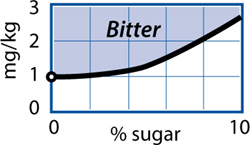
In plain water, bitter limonin can be tasted at 1 mg/kg (or higher concentrations); it takes almost three times as much when mixed into a 10% sugar solution (Guadagni, 1973).
The taste of bitter is unusual in that we learn to enjoy it. We know bitterness is a learned preference—different cultures have different preferences for it, with Americans and the British placing less emphasis on it than other cultures—but whether we learn to like bitter flavors because of exposure effects or social conditioning is an open question. It is clear that we don’t like bitter foods at the start of our lives. This “learning to like” is why bitter foods are unappealing to kids: they haven’t learned to tolerate, let alone enjoy, the sensation of bitterness. Dandelion greens, rhubarb, and undercooked artichoke leaves all contain bitter-tasting compounds. Not surprisingly, I couldn’t stand those things as a kid; as I’ve gotten older, I’ve come to enjoy the bitterness of something like dandelion greens in a salad.
Bitter can also be a confusing taste. A surprising number of people confuse bitter and sour tastes for each other—around one in eight English-speaking people incorrectly describe citric acid in water as tasting bitter, not sour. Coffee is commonly described as bitter, but it can also be quite acidic, giving it a sour taste in addition to its stronger bitter taste. Bitterness seems to lend itself exceedingly well to other drinks besides coffee: black tea, hops (used in making beer), and kola nuts (kola as in cola as in soft drinks) are all bitter. Like all bitter foods, they’re still delicious—if you’ve learned to like them!
Tips |
• Genetic differences in bitter taste sensations change preferences for sweet items, especially in children. When serving others, remember that we don’t all experience the same “taste landscape” and that differences in food upbringing change how much bitterness an eater will enjoy. • Salty and sweet tastes mask bitterness. Try a simple “bitter taste test” using modern tonic water, which uses quinine as a bittering agent and is easy to get at the grocery store. (Look for one free of any sweetener.) Pour tonic water into two drinking glasses. In one, add enough salt to neutralize the taste. Compare the taste of the tonic water in the two glasses. |
To make something bitterer |
• It’s telling that, unlike with all the other tastes, we don’t have a standard seasoning to make things more bitter! Use a bitter ingredient such as bitter greens or cocoa (see page 63). |
If a dish is too bitter |
• Increase saltiness or sweetness to mask. A pinch of salt in a salad that contains bitter items such as dandelion greens helps balance the flavor. • Try adding a fatty ingredient. Some studies show that moderate levels of fat reduce the sensation of bitterness without impacting other tastes. |
Savory, a.k.a. Umami
Savory tastes, sometimes called umami, generate lip-smacking sensations that are the hallmark of rich foods. Pizza, meats, and hard aged cheeses like Parmesan tend to be high in savory-tasting compounds, as are good broths, mushrooms, and tomatoes. While savory tastes are less discussed in Western cuisine than the four tastes described so far, they are foundational to Japanese cuisine. Savory taste receptors were only recently discovered; in 2002, researchers found a mechanism for these that has similarities to how sweet receptors work, ending any arguments that savory/umami is not a true taste.
The Japanese emphasis on savory tastes is a fascinating quirk of geography, climate, and the resulting edible plants. Japanese cuisine is the only one to make consistent, extensive use of seaweed, and seaweed happens to be very high in the chemical compound glutamate. It’s this compound, in the form of glutamic acid, that was first identified by a Japanese chemist, Kikunae Ikeda, in 1908. He initially used the Japanese word for delicious, umai, to describe how it increases the sensation of other tastes, suggesting umami and then “glutamic taste” as a name for the sensation. While others had described the taste sensation before—the French foodie Jean Anthelme Brillat-Savarin mused about it almost a century earlier when he wrote about osmazome—it was Ikeda who successfully isolated and commercialized it.
Unable to conjure a memory of a savory taste? Make a simple broth by rehydrating a tablespoon of dried shiitake mushrooms in 1 cup (240 mL) of boiling water. Let the mushrooms steep for 15 minutes. Taste the liquid; it will have a high level of glutamic acid from the mushrooms. (Alternatively, you can dissolve a small amount of MSG in a glass of water, but it’ll also taste salty from the sodium.)
To an average Western palate, savory tastes are subtler than the four primary Western tastes. This isn’t surprising, because only a few of the everyday ingredients used in Western cooking have tastants that trigger the savory sensation. Sauces like ketchup and fish sauce (used by the ancient Romans) are typical sources for savory flavors; adopted items like soy sauce are also common. (Modern ketchup is a taste miracle: sweet, salty, savory, and even a little sour, but not bitter—no wonder kids love it!)
From a biological perspective, savory receptors on the tongue sense nucleotides and amino acids such as glutamate. Glutamate—the same glutamate in monosodium glutamate (MSG)—is the most common compound that triggers savory taste. While Ikeda initially described the taste sensation as being glutamate-sensing, it’s actually a broader phenomenon. Inosinate, guanylate, and aspartate are also naturally common in ingredients. Pragmatically speaking, though, the easiest way to add a savory taste is to use ingredients high in free glutamate. (Free glutamate can dissolve away from the food in order to bind with the receptors on your tongue; bound glutamate isn’t easily detected.)
Why do we sense compounds like glutamate? Unlike with other tastes, we don’t have a biological predisposition for savory sensations, although we do gravitate toward them. Presumably there was an evolutionary advantage to ensuring we ate protein-rich foods, as they provide necessary amino acids to build and repair muscle tissue. The very first thing many of us taste in life—human breast milk—is surprisingly high in glutamate. Just as sweetness and saltiness are associated with positive attributes of food (quick energy in the case of sweet and an element essential for regulating blood pressure in the case of saltiness), our craving for savory tastes ensures we ingest enough amino acids. Regardless, the savory taste is worth understanding for its hedonistic value.

Free glutamate content of common ingredients.
There are plenty of natural sources of glutamate. The British and Australian fondness for vegemite is due to its savory kick. Many traditional Japanese dishes call for dashi, a stock made from ingredients high in natural glutamate, such as kombu seaweed (2.2% glutamate by weight). Making dashi is easy: in a pot, place 3 cups (720 mL) cold water and a 6” / 15 cm strip of kombu (dried kelp), and let the mixture rest for 10 minutes. Bring it to a boil slowly on low heat. Remove the kombu just before the water begins to boil and add 10g of bonito flakes (flakes of dried and smoked bonito fish). Bring the water to a boil, remove it from the heat, and strain out the bonito flakes. This liquid is dashi. To make miso soup, add miso paste, diced tofu, and (optionally) sliced green onions, nori, or wakame (an edible seaweed).
Glutamate occurs naturally in many other foods—for example, beef (0.1%) and cabbage (0.1%). And if you’re like most geeks and pizza makes your mouth water, it might be because of the glutamate in the ingredients: Parmesan cheese (1.2%), tomatoes (0.14%), and mushrooms (0.07%). Besides using ingredients naturally high in glutamate compounds, you can add glutamate directly to food by using MSG. MSG is to savoriness as sugar is to sweetness: as a chemical, it’s mostly odorless (still full of taste!), but it triggers the receptors on the tongue.
Increasing the sensation of savoriness has an ancillary benefit: it amplifies our other senses of taste. Savoriness increases the sensation of salty and sweet compounds, meaning that you can cut the amount of salt in a dish by adding savory-tasting ingredients or using MSG. (If using MSG, you should reduce salt regardless because it dissolves and disassociates into a sodium ion and glutamate, with the sodium ion increasing the salty taste.)
Sensitivity to monosodium glutamate, called MSG symptom complex by the medical community, has been found to temporarily affect around 1 to 2% of people. Intolerant individuals, given 3 grams of MSG without any other food, may experience short-term symptoms like headaches, numbness, or flushing about an hour later. Amounts of MSG added to foods don’t generally exceed 0.5 grams, and double-blind controlled studies with placebos cast plenty of doubt on individuals who claim sensitivity.
Tips |
• For vegetable dishes and vegetarian cooking, add ingredients high in glutamate to improve overall flavor. |
To make something more savory |
• Use savory ingredients such as corn, peas, tomatoes, Parmesan cheese, or soy sauce. • Use cooking techniques that increase savory compounds (e.g., curing and fermenting foods like bacon, soy sauce, and fish sauce increases their glutamate levels). • Add MSG, depending on how you feel about it. (The “Chinese restaurant syndrome” of MSG causing an allergic reaction is entirely placebo—no controlled study has ever replicated it—but placebo effects can be strong!) |
If a dish is too savory |
• No good counteraction; try dilution. |
Spicy/Hot, Cooling, and Other Taste Sensations
In addition to the primary sensations of taste, our taste buds also register a set of sensations related to the chemical properties of some foods that with exposure we learn to enjoy. In culinary applications, chemesthesis—sensations caused by chemical compounds—contributes to the taste of everything from hot peppers to pungent garlic to cooling menthol candies.
Spicy hot sensations are the most common form of culinary chemesthesis. Compounds such as capsaicin in hot peppers both irritate cells and trigger the same mechanism used to detect hot temperatures, using a neurotransmitter called substance P (P is for pain; go figure). In one of nature’s quirkier moves, substance P is slowly depleted as it is used and takes time—many days, possibly weeks—to replenish. This means that if you eat hot foods often enough, you will build up a tolerance for hotter and hotter foods as your ability to detect the presence of compounds like capsaicin decreases. Because of this, asking someone else if a dish is spicy won’t always tell you if it’s safe to jump in; he or she may be a regular eater of spicy foods. Also, as you expose yourself to spicy food, you’ll need more and more of the ingredients that bring the heat to get the same level of sensation.
Spicy pungent sensations can be triggered without tripping the hot temperature mechanism. Garlic, wasabi, and mustard can all cause a smarting, mind-searing reaction, as do some stinky French cheeses that have sharp, caustic qualities. Szechuan (also known as Sichuan) peppers, used in Asian cooking, and Melegueta peppers, used in Africa, cause a mild pungent as well as a numbing sensation.
Chemesthesis includes a number of other sensations besides spicy hot and pungent. Peppermint candies get their cooling effect from the chemical menthol, which occurs naturally in mint oils from plants such as peppermint. Menthol activates the same nerve pathways that cold temperatures do, which is why chewing mint gum or eating mint candies can cause a tingling cold reaction.
Spilanthol, the active ingredient in the edible flower Szechuan buttons (also known as sansho buttons, buzz buttons, or electric buttons and unrelated to Szechuan peppers), triggers receptors that cause a numbing, tingling sensation. The “buttons” are actually the flowers of the Acmella oleracea plant. The tingling reaction is like licking the terminals on a nine-volt battery—a curious sensation, should you be up for splurging on an online purchase.

Our mouths capture data for other aspects of oral irritation, too. Astringency, a drying, puckering reaction, occurs when certain compounds (normally polyphenols) dry the mouth out, possibly by binding to proteins in saliva that normally provide lubrication. Astringent foods include persimmon, some teas, certain unripe fruits, and lower-quality pomegranate juices (the bark and pulp are astringent). Carbonated beverages also cause cellular irritation, partly masking other taste sensations at the same time. Try sipping on some bottled seltzer water and then “de-fizzing” it (screw the cap back on, shake the bottle, and carefully unscrew the lid to slowly vent the gas). Depending upon the brand, you may be shocked at how salty the flat water will taste. (Carbonation also interacts with an enzyme, carbonic anhydrase 4, to activate our sour taste receptors, but for now it’s unclear why it doesn’t actually taste sour to us.) Sour foods can also trigger oral irritation, although much less noticeably so than many of the other taste sensations involved in chemesthesis.
Most European cultures don’t consider spicy/hot to be a primary taste; other cultures, like the Thai, do, and Ayurvedic medicinal practices on the Indian subcontinent define “warm” as part of basic food prescriptions. Why the difference? One theory suggests genetic differences in taste receptors between Europeans and natives of other regions. (More taste receptor cells = more cells that can be irritated.)
Tips |
• Spicy foods decrease the perception of sweetness and saltiness; they can increase the ability to detect some odors while decreasing others. |
To make something spicier |
• Use hot ingredients such as cayenne pepper (capsaicin) or black pepper (slightly pungent due to the compound piperine). |
If a dish is too spicy |
• Capsaicin is a nonpolar molecule (see page 59), which is why sugary and fatty ingredients are better able to partly neutralize it while drinking water does little to reduce the burning sensation. Dairy works well, for multiple reasons: casein proteins bind to capsaicin and lactose sugars help dissolve capsaicin into solution. If a dish is too hot, ideally add dairy; otherwise, add something with sugars or fats to reduce the heat. |
DIY Scoville Scale
Wilber Scoville, an American pharmacist, spent a lot of time at the turn of the 20th century looking at how to extract compounds from plants. His most famous contribution is an organoleptic test—one that relies on the senses—for measuring the amount of capsaicin in hot peppers. Organoleptic tests aren’t particularly accurate (what one person senses will be different over time and different from what others sense), but they do have the advantage that you can do them at home.
Scoville’s method, first published in 1911, is easy, relying on dried powders from various peppers (a.k.a. capsicum): “One grain [64.8 mg] of ground capsicum is macerated over night in 100 cc. of alcohol [78.9g], and after thorough shaking, filtered. This alcoholic solution is then added to sweetened water in definite proportions until a distinct but weak pungency is perceptible on the tongue.” He doesn’t specify how much sugar to use in “sweetened water,” but 10% sugar to water is a reasonable start, should you wish to try it; for alcohol, use a neutral grain alcohol like vodka. To determine the Scoville score for a pepper, calculate how diluted the ground capsicum is in the just detectably hot solution. Use a few varieties of hot peppers so you can do relative comparisons!
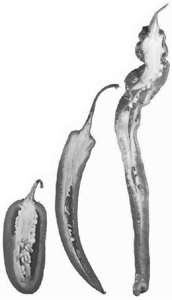
Inspiration by Taste Combinations
Combinations of ingredients can change the flavors of what we eat in surprising ways. A pinch of salt can change the flavor of a dish by reducing bitterness, which in turn increases the perception of sweetness. This type of interaction is why adding an ingredient that brings taste to a dish can also bring balance and boost the sensation of desirable flavors.
Most combinations of tastes—salty + sweet, bitter + sweet—also change flavors. This is a remarkable thing! Changes in tastes, things that your tongue detects, can change aromas detected by your nose. The gustatory and olfaction systems are generally thought of as being separate, but there is overlap. Even at undetectable levels, small quantities of cayenne pepper can increase our ability to detect the aromas of seemingly unrelated items, like grape in grape jelly. Our senses are a complicated system, with the thresholds and intensities at which we register and detect a compound being changed by other compounds.

When cooking, taste the dish you’re working on and ask yourself what sensations are too strong or too weak. Sometimes the fix is simple: fresh fruit that’s slightly dull can be sprinkled with sugar (try this on strawberries), lightly salted (on grapefruit), or wetted with lime juice (papaya, watermelon, peaches with honey). More inspiring solutions combine ingredients with different primary tastes (sweet watermelon and salty feta cheese). Try using nontraditional taste combinations: Strawberries and black pepper? Mango salad with jalapeños and cilantro? Mixing up the basic taste combinations can be great inspiration.
Taste combinations extend beyond the classic definitions of tastes. Try experimenting with spicy/hot ingredients, pairing them with other basic tastes. Spicy + sweet? Buffalo wings! Mixing in fats can shift tastes as well, as compounds like capsaicin are fat soluble. Experiment with avocado and sriracha sauce, commonly known as rooster sauce for the drawing on the bottle of one popular brand. Sriracha sauce, it has been claimed, can improve any dorm food, but be forewarned: it can hit you like a freight train if you use too much!
Adding a pinch of salt or sugar, or ¼ teaspoon (0.5g) of cayenne pepper, may not cause you to taste the food as saltier, sweeter, or hotter, but it can change the flavor! You may not notice the change when cooking, though. If you’re sampling food and focused on one aspect, you will very likely miss changes to other aspects. The field of sensory analysis—measuring perceptions of the human senses—is fascinating and complex.
Many foods are combinations of three or more primary tastes. Ketchup, for example, is surprisingly complex, with tastes of umami (tomatoes), sourness (vinegar), sweetness (sugar, tomatoes), and saltiness (salt). If combining tastes in a dish becomes too challenging, serve two separate components side by side, pairing one dish with a second on the basis that the two will complement each other.
Combination |
Single-ingredient example |
Combination example |
Salty + sour |
Pickles |
Salad dressings |
Salty + sweet |
Seaweed (slightly sweet via mannitol) |
Watermelon and feta cheese |
Sour + sweet |
Oranges |
Lemon juice and sugar (e.g., lemonade) |
Bitter + sour |
Cranberries |
Negroni (cocktail with gin, vermouth, Campari) |
Bitter + sweet |
Bitter parsley |
Bittersweet chocolate |
Bitter + salty |
(N/A) |
Sautéed kale with salt |
Smell, the Olfactory Sense
Smell is simple in the abstract and complicated in the details. In the abstract, smells lead us toward the desirable and steer us away from the unsafe. But smell does this in a much broader context than food. Choosing whom to mate with? Helping infants identify their mothers? Helping me figure out if that worn-once shirt can be safely worn again? All of these things rely on our sense of smell, formally called olfaction, and the complication in olfaction is the number of roles that it has evolved to play.
While the sensation of taste is limited to a handful of attributes, smell is a cornucopia of data. We’re wired to detect around 360 distinct attributes and are able to discern and remember over 10,000 aromas. Add in intensity aspects, and we can discriminate between a trillion different possibilities. Our sensitivity is incredible, too. The human nose can detect some compounds below the order of one part per trillion. To put that in perspective, it’d be like being able to spot a single grain of rice while viewing all of Manhattan from space. Without smell, the flavors of foods would be limited to a handful of basic tastes and life at the dinner table would be a lot more boring.
How we sense smell is a fascinating topic, and one that’s only relatively recently understood. The Nobel Prize in Physiology or Medicine was awarded in 2004 to two researchers, Richard Axel and Linda Buck, for their work in discovering the mechanism by which we sense smells. Like our sense of taste, our sense of smell is based on receptor cells being activated by chemical compounds. In smell, these compounds are called odorants, and they activate chemoreceptor cells in our noses. But there are many more details to the story of smell.
At first glance, smell and taste receptor cells work in similar ways. As in taste, odor receptor cells are built to detect exactly one attribute, and each receptor cell is encoded by exactly one odorant receptor gene. Just as “sweet!” taste receptors can be triggered by different compounds—sucrose, fructose, saccharine—different compounds can trigger any given smell receptor. In the case of olfaction, the receptor cells are located in the nasal cavity and respond to volatile compounds—chemicals that evaporate and can be suspended in air such that they pass through the nasal cavity, where the odor receptor cells have a chance to detect them.
Where things get more complicated in smell is in the variety of odor receptor cells and how they activate in groups. Unlike taste, where there are a handful of easily named sensations, smell has many, many more possible sensations. We use words like musty, floral, or lemony to describe categories of common sensations, but these sensations don’t come from any one odor receptor. Smell is complicated for this one remarkable fact: a single compound activates multiple odor receptors, and the combination of odor receptors that are triggered is what we register as a smell. Layer on a second critical fact—that aromas, from flowers to coffee, are based on mixtures of compounds—and you can see why smell is so complex.

From a biological point of view, a tastant is like a single note being played on a piano and an odorant is like a neurological chord. In taste, we register a sensation based on one taste receptor cell firing off; in smell, we register an odorant based on the combination of olfactory receptor cells that fire off. A compound like vanillin, the molecule that gives vanilla most of its aroma, will trigger multiple olfactory receptor cells, and our brain registers that combination as “vanilla-like.” Regular vanilla, in its full glory, is based on a handful of odorants from the vanilla bean, and we detect all of those in one pass, like many different chords being played at the same time, for a symphony that registers “vanilla!”
This also explains what happens if you’ve ever experienced a partial whiff of an odor and misidentified it. When some of the “notes” are missing, your brain’s pattern-matching machinery goes to work and finds its best guess. Recently I was walking out of my apartment with a stuffed-up nose, which decreased my ability to smell. When stepping into the hallway, I smelled apricots, but as I walked down the hallway and more odorants hit my olfactory system, the smell suddenly switched to that of drying paint. How could I have “missmelled” something that different? Only some of the neurons in my stuffed-up nose had fired off at first, and the chord they were striking was similar enough to apricots that my brain autocompleted it to the nearest thing it could find. (Why apricots? I have no idea.)
Your brain fills in missing details to match up with your historical experiences, which is why you should identify this drawing as an incomplete triangle.

Not all compounds can be smelled. For one, compounds have to be volatile—having the ability to turn into a vapor through evaporating or boiling. For us to smell something, it has to be “in the air.” When you unwrap a bar of chocolate and smell it, that’s due to compounds in the bar of chocolate evaporating and drifting through your nasal cavity. Chocolate is loaded with volatile compounds, while your stainless steel spoon has very few, which is why you can smell one but not the other. A compound’s volatility also changes with temperature. We have a harder time smelling cold foods because temperature partially determines a substance’s volatility. (Incidentally, the evaporation of the volatile compounds makes the bar of chocolate infinitesimally lighter as time goes on, in case you need an excuse to eat that bar of chocolate right now.)
While some foods have naturally strong smells, most raw ingredients keep their odors to themselves until disturbed. An unpeeled banana, a head of lettuce, and fresh fish don’t have much of an aroma until they’re worked. Cooking adds many odorants by either freeing volatile compounds or breaking down nonvolatile compounds into new ones. Even chopping up leafy greens and vegetables releases smells, as anyone who’s cut an onion knows. Think about the difference in smell before and after you mow a lawn—the “green” grassy smell is from compounds that were trapped inside the blades of grass before they were cut.
It’s not enough for a compound to be volatile and “freed” for us to detect it. Size, shape, and something called chirality all determine whether a molecule is smellable and how. Our sense of smell is on par with modern lab equipment, on the hunt for specific types of things. We’re capable of distinguishing the difference a few atoms makes—we can smell both octane and nonane, only two hydrogen atoms and a single carbon atom apart; the primary odorants of pear and banana also differ by only two hydrogens and one carbon.
A real surprise with smell is the impact of chirality, which has to do with whether a molecule and its mirror version (the pair are known as enantiomers) are identical. Your left and right hands, for instance, are chiral because they are not identical, even though they have the same fundamental shape. Carvone is a classic example in chemistry: the compound S-carvone smells of caraway, while its mirror version, R-carvone, smells of spearmint. That’s how specific the collection of odor receptor cells that activate can be!

Octane

Nonane
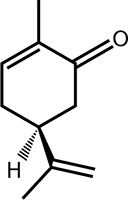
S-Carvone

R-carvone
There are general rules of thumb for odors and volatile compounds, understandable to chemistry geeks. The families of compounds that contain certain chemical structures generally end up smelling similar. One category of compounds, call esters, are classically thought of as having fruity aromas. Another category, amines, smell stinky and rotting, like week-old raw fish, with cadaverine and putrescine being two of the better-known odors. And another group, aldehydes, tend to smell green or plantlike. This commonality supports the theory that part of smell detection stems from receptors that activate based on parts of a volatile compound’s chemical structure.
While smelling a single compound won’t bring the entire aroma of something like cut grass, some compounds are similar enough that flavor chemists can use a handful of them (in the case of grass, hexenal, hexenyl acetate, and methanol) to trick our brains into thinking we’re smelling the real thing. Artificial scents—used in products from laundry detergent to candies—often cost less, can be more stable chemically than the original scents, and can even be safer (“natural” can have natural toxins). Artificial vanilla extract, for example, generally contains just vanillin, which happens to be the most common chemical in vanilla. Although the artificial stuff is missing all the other compounds from vanilla, we still register it as vanilla and generally find it to be enjoyable.
As you can see, the chemistry aspects of smell are complicated in their details, and we haven’t even touched on individual differences in how we detect odors! Here are a few differences in smell that you might want to consider, especially when cooking for others:
Genetic differences. Just as there are genetic differences in taste, there are genetic differences in smell. The simplest example is cilantro: to some, it registers as dish soap and is disgusting; to others, it’s a pleasant addition to a meal. If you’re a cilantro hater, you’re in good company: Julia Child hated it too. We know cilantro aversion is due to a slight genetic variation (search for rs72921001 online); about 1 in 10 of us has it, and that number is slightly higher for those of European ancestry and slightly lower for those of Asian ancestry.
Threshold differences. Other physiological differences are known to exist. Females have about 50% more neuronal connections in the olfactory bulb than males, increasing their ability to detect odors. Some people are much more sensitive to smells than others, presumably for genetic reasons. These differences mean that there are variations in the minimum thresholds necessary for various odorants to register. Because aromas are combinations of odorants, and different aromas have overlaps, if I’m capable of detecting all the odorants in the aroma but you only smell a subset, I might smell floral lilies and you might smell something almost fecal-like.
Age-related changes. Like eyesight and hearing, our sense of smell begins to deteriorate sometime in our thirties and starts to fall off faster once we reach our sixties. It’s a slow decline, and unlike hearing and eyesight, is hard to notice as it changes, but the loss does impact our enjoyment of food to some degree.
Just like we hear in stereo, it appears that we smell in stereo: we use our left and right nostrils independently. Researchers at the University of California, Berkeley, have found that with one nostril plugged up, we have a much harder time tracking scents, due to lack of “internostril communication.”
Crossover. The senses of taste and smell aren’t completely isolated from each other. Odorants can change how we perceive the basic tastes. Vanilla aroma, for example, will increase how sweet something tastes. Fruits like blueberries are “sweeter” than strawberries, in the sense that blueberries have more sugar, but the odors in strawberries cause us to perceive them as sweeter instead. Experiments have shown that smelling sweet foods like caramel and then sipping water causes us to taste it as sweet.
Olfactory fatigue. Be grateful for olfactory fatigue; without it, you’d constantly smell whatever background smells exist in your home or while you’re out and about. Smells begin to fade into the background after a few minutes, presumably as the brain tunes them out. Coffee beans at the perfume counter are supposedly used to reset fatigue, but research doesn’t back this up as being effective—well, at least not for resetting the nose (but perhaps your wallet?).
What’s the difference between artificial and natural vanilla extract?
In the United States, natural vanilla extract must be made from vanilla beans (~10.5% by weight) in a base that’s at least 35% ethyl alcohol, while artificial vanilla extract is based on synthesizing the chemical compound vanillin, which is responsible for vanilla’s primary aroma.
Depending upon manufacturing, artificial and natural extracts can be chemically indistinguishable, although what you see in the store usually has some differences. Artificial vanilla extract can have other compounds (e.g., acetovanillone) that change the extract’s odor. Some of these other compounds are described as “more vanilla than vanilla”—they register as stronger odors—so artificial extract can seem stronger than a vanilla bean–derived one.
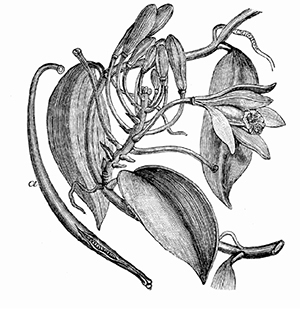
Describing Smells
Unlike with tastes, where everyday language makes it easy to describe a sensation such as “salty,” describing smells can be a challenge. We don’t have common language to describe strawberries other than “strawberry-like”—which is great if you’ve had strawberries, but how would you describe a durian fruit? Coffee roasters, winemakers, and cheesemongers all have their industry-specific odor descriptions, but it’s the flavor chemists who really know how to talk about smell.
Descriptive taxonomies apply labels to odors as a way of classifying and grouping foods. The simplest descriptive taxonomy, from the 1950s by J. E. Amoore, proposes just seven primary odors: camphoric (like mothballs), ethereal (like cleaning fluid), floral (like roses), musky (like aftershave), pepperminty, pungent (like acetic acid in vinegar), and putrid (like rotten eggs). Small taxonomies like this suffer from disagreement—what do the definitions mean? If I were to smell chocolate, I’d have no idea how to categorize it.
More modern descriptive taxonomies use larger vocabularies and are used by trained assessors. One of the more common ones is the American Society for Testing and Materials’s Atlas of Odor Character Profiles – DS61, by Andrew Dravnieks. While not all of the terms included are pleasant or even related to food, it’s certainly a diverse set, which is useful in thinking about smells. The full atlas includes hundreds of volatile compounds associated with the various terms. And, with 146 terms, Dravnieks’s list provides enough granularity to begin to form a meaningful model for odors.
Another label-based classification system, Allured’s Perfumer’s Compendium, is used by the perfume industry, the fine folks responsible for the smells of products from laundry detergent to toothpaste. Think that new car smell is accidental? Trained employees smell the materials that go into the interior of a new car to make sure that it smells just right. (To quote The Matrix: “You think that’s air you’re breathing now?”) Allured’s taxonomy uses more descriptive and narrow scents—familiar items such as banana, peach, and pear—but also specific items like hyacinth, patchouli, and muguet (lily of the valley), making it less useful to the layperson.
Descriptive taxonomies are by no means perfect. For example, both lemon and orange are classified as “fruity/citrus” in Dravnieks’s list. Descriptive taxonomies allow for some comparison of odors, but they’re not a chemical analysis, where the presence and quantities of various compounds are measured. Still, they’re fun to peruse and give you a real sense of how much better we could talk about smell if we shared a common vocabulary. Even with such a list, describing smells is more of a literary exercise than a scientific one. One sommelier friend, tired of being asked to describe wine to customers, finally flipped out and said, “If kittens could fart rainbows, it would smell like this.”
REPRINTED, WITH PERMISSION, FROM DS61 ATLAS OF ODOR CHARACTER PROFILES, COPYRIGHT ASTM INTERNATIONAL, 100 BARR HARBOR DRIVE, WEST CONSHOHOCKEN, PA, 19428
Flavor chemists use databases of odorants with descriptive odor terms. For example, Flavornet (http://www.flavornet.org), created by two researchers at Cornell (Terry Acree and Heinrich Arn), describes some 700+ chemical odorants detectable by the human nose. Listing compounds such as citronellyl valerate (smells like honey or rose; used in drinks, candies, and ice cream), the database is useful for generating certain flavors artificially—what compounds smell like X?
What Is Flavor?
Flavor is a Jedi trick of the mind, a combination of the gustatory sense of taste and the olfactory sense of smell that your brain fuses into a new sensation. To give you an idea of just how clever your brain is about flavor, consider this: your brain detects odors differently based on whether you are breathing in or out. This is crazy! It’s like saying swiping your hand left to right on a cold countertop causes you to feel temperatures differently than swiping right to left. Our brains are wired to process smell signals in two different ways; flavor uses the second way.
Some definitions will make this easier to discuss. Orthonasal olfaction is defined as what your nose detects from sniffing something that exists in the world. Sniffing a rose, unless you’re also chewing it, uses the orthonasal route for smell. Retronasal olfaction is what your nose detects in the foods you eat when air is taken in from the mouth and circulated up to your nasal cavity. Even if you don’t notice it happening, it is! Try chewing food with your nose pinched: cut off the airflow, and poof, the flavor sensation’s gone.
To unravel this trick of the brain, a researcher, Paul Rozin, gave subjects unfamiliar fruit juices and soups via the orthonasal route—“Here, sniff this; remember this odor”—and then gave the foods to the subjects again via the retronasal route (through a plastic tube), asking them to identify the previously remembered odor. They did horribly. Same compound, same sensory apparatus, completely different experience. As I promised, smell is simple in the abstract but complicated in the details, so it follows that flavor is no different.
From a practical perspective, which flavors you’ll like or dislike is a matter of exposure and preference. Rozin started studying the orthonasal and retronasal issue when stumped by stinky cheeses—how is it that we have a different experience of flavor for something that smells disgusting? There’s a lot that psychologists and physiologists are still exploring. Fortunately, you needn’t be one to cook a good meal. When working with food, keep in mind that flavor is a specific combination of the two senses of taste and smell, but not a straightforward summation of the two. Taste the food to adjust its flavor before serving it! Smelling alone isn’t enough.

Here are some tips for great flavor when cooking:
Chew! Admittedly an odd suggestion for good flavor, chewing food crushes, mixes, and kicks up a bunch of compounds for your olfactory system to detect, adding smells that fold into flavor sensation. Remember, for a compound to activate an odor receptor, it has to be present at the point of detection. This raises the question: does chewing food with your mouth open lead to a different flavor experience? (If animals always chew with their mouths open...)
Use fresh herbs. Most dried herbs have weaker flavor because the volatile oils that are responsible for the aromas oxidize and break down, meaning that the dry herbs are a pale substitute. Dried herbs have their place, though; it makes sense to use them in the dead of winter when annual plants like basil aren’t in season. Store dry herbs in a cool, dark place (not above the stove!) to limit their exposure to heat and light, which contribute to the breakdown of organic compounds in spices.
Grind your own spices. Don’t used preground black pepper; it loses much of its flavor over time as many of the volatile compounds change. Fresh-grated nutmeg is also much stronger than preground nutmeg. The aromatics in a preground spice will have had time to either hydrate or oxidize and disperse, resulting in flavor changes. Most dried spices also benefit from being bloomed—cooked in oil or a dry skillet under moderate but not scorching heat—as a way of releasing their volatile chemicals without breaking them down.
Don’t discount frozen ingredients. Commercially frozen vegetables and fruits are convenient and work fine in some dishes. Freezing produce right when it is harvested has advantages: nutritional breakdown is halted, and the frozen item is from the peak of the season with maximal flavor (whereas the fresh version in your store may have been harvested early or late). Frozen produce is especially useful if you’re cooking for just yourself: you can pull out a single portion as needed. Want to freeze your own crop or a surplus from a CSA (community-supported agriculture) food share? See page 365 for how to use dry ice. (Freezing in your home freezer takes too long and leads to mushy veggies.)
Use alcohol in cooking. My favorite restaurant in San Francisco uses kirschwasser in its fruit soufflés, and adding a splash of wine in sauces or to deglaze a pan to make a quick sauce is standard practice. Using alcohol changes flavors because of its chemistry: it takes the place of water molecules normally attached to compounds, resulting in lighter molecules that are more likely to evaporate, and with higher evaporation rates there are more volatiles for your nose to detect.
Inspiration by Exploration
Unlike our innate preferences with primary tastes, we don’t have innate likings or dislikings for most odors. The flavors we enjoy are flavors we’ve learned to enjoy, which is why other cultures’ foods can be literally foreign to us. This is also why cultural culinary exploration is a fantastic way to learn new flavors! Some of my favorite meals are based on familiar ingredients cooked in new combinations, often based in other cuisines. The first time I had chicken tagine, a North African dish of stewed chicken, it was both familiar (chicken legs, tomatoes, onions) and exotic. (Tagines, by the way, are named for the dish they’re cooked in, the combination of ingredients being whatever you have on hand.) The trick to this type of flavor inspiration is to learn about flavors and the ingredients that provide them. But how do you get that knowledge? Here are a few ways to explore with flavors, geographical and otherwise.
Ask about ingredients in foods you’re eating. Take time to notice the aromas in the foods you are eating, taking note of smells that you don’t recognize. Next time you’re eating out, order a dish you’re not familiar with and try to guess its ingredients. If you’re stumped, don’t be shy about asking the staff. I remember being served a roasted red pepper soup and being completely stumped as to what provided the richness and body (thickness) of the soup. Five minutes later, I found myself sitting across from the chef (it was a slow night), who had brought me the kitchen’s working copy of the recipe and told me its real secret, Armenian sweet red pepper paste. I learned not just about a new type of flavor that day, but also about a new technique (toasted French bread puréed into the soup—an old, old trick to thicken soups) and the location of a great Armenian grocery store in the neighboring town.
Play “culinary mystery ingredient.” Next time you’re at the grocery store, buy one thing you like to eat but have never cooked with before. For “intermediate players,” pick up something you’re familiar with but have no idea how to cook. And if you’ve progressed to the “advanced” level, choose something that you don’t recognize at all. You’d be surprised at how many foods can be unfamiliar in their ingredient form, but once cooked into a meal are familiar, or maybe even downright commonplace. Yucca roots? Try making yucca fries. Lemongrass and kaffir lime leaves? Try making tom yum soup. With tens of thousands of items available in the average grocery store, you should be able to find something new to inspire you.
Mimic flavorings from another dish. If you’re just now learning your way around the kitchen and aren’t yet familiar with that many recipes, think about the ingredients that go into foods you like. Even a simple peanut butter and jelly sandwich can inspire: imagine a grilled chicken skewer coated with a sweet jelly and sprinkled with chopped toasted peanuts. Maybe you like your pizza topped with onions, tomatoes, and basil. Experiment by using those toppings in a pasta dish or as toppings on bread as an appetizer (bruschetta!).
What people from one culture enjoy can be unpleasant to those from another culture. Gourmet Magazine ran a great article (August 2005) about three acclaimed Sichuanese chefs from China eating at one of the top restaurants in the United States. The flavors didn’t strike chords in the ranges for which the chefs had formed much appreciation. Invariably there will be some differences between your tastes and those of your guests—hopefully you’re not cooking for acclaimed Sichuanese chefs!—so don’t be surprised if a combination of flavors that you love is merely okay to others.
Search online with a list of ingredients already in play. If you’re improvising a North African tagine or a stew using tomatoes, onions, and lamb but aren’t sure what foods and spices might round out the flavors, run an online search for those ingredients along with the word “recipe” and see what the Internet says. Just scanning the titles of pages listed in the search results can be enough—in this case, coriander, potatoes, and chili powder are a good bet.
Use similarity as a good gauge of compatibility. If a recipe calls for A, but B is extremely similar, try using B instead and see if it works. Kale and chard are both hearty green leaves that can be substituted for each other in many dishes. Likewise, provolone and mozzarella cheese both have mild flavor and share similar melting properties, so using one in place of the other in foods like omelets makes sense. Similar foods aren’t always interchangeable. They each have their distinct flavors, and if you attempt to recreate a traditional dish with substitutions, you won’t faithfully reproduce the original. But if your goal is to make an enjoyable dish, experimenting with similar ingredients is a great way to see where things line up and where they diverge.
Remember to adjust quantities to create great flavor. One of the most important levers for flavor isn’t new ingredients, but adjusting quantities of existing ones. Lean in and smell the dish. Then take a taste. What flavors are out of balance? Does it need more of the seasoning ingredients? More salt? If it’s dull or flat, would adding more of a sour ingredient (lemon juice or vinegar) add some brightness?



